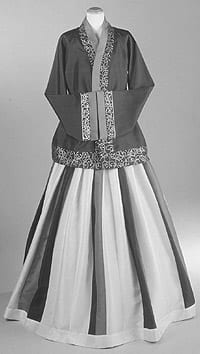Korean Costumes through the Ages
November 1, 2003 – February 1, 2004
Korea has one of the world’s richest costume and textile traditions, one that is distinct from neighboring countries such as China and Japan.
The year 2003 marks the centennial of Korean immigration to the United States. To celebrate this important anniversary, Pacific Asia Museum is hosting a major exhibition of Korean costumes, from the National Folk Museum of Korea. Korean Costumes through the Ages will be the first exhibition of its kind in Southern California to trace the development of Korean dress, or hanbok, from the Three Kingdoms Period (1st century BC- AD 668) to the modern period.
Curated by Dr. Kim Young Jae, this exhibition will focus on Korean clothing as it has evolved over the centuries. It will include over 50 costumes and accessories that were worn primarily by members of the Korean aristocracy. Some of the costumes presented will be rare original pieces from the periods they represent. For the earlier periods, from which no examples remain, reproductions copied from costumes depicted in paintings and sculpture of those early periods will be presented. In addition, some examples of contemporary Korean clothing designs will also be featured.
From excavations of early archaeological sites on the Korean peninsula, it is evident that the Koreans wore clothing of silk, hemp and wool over 2,000 years ago. Silk cultivation and production developed during the Three Kingdoms period and for a long time were controlled by the government, so that silk clothing was primarily worn by members of the nobility. It was only during the Joseon (Choson) period that silk clothing became widespread among the general populace. Clothing made from hemp fiber was worn more widely among the population, as was wool, which protected the wearer from the bitter cold of Korean winters. For summer clothing, ramie (similar to linen) was preferred as it dries quickly and air passes through the loose weave to cool the body. Cotton clothing was introduced in the Goryeo (Koryo) period (918-1392) and by the Joseon period was being used widely and even exported to Japan.
Over the centuries, Korean traditional dress has featured forms, styles, color schemes and decorations that are uniquely Korean. From as early as the Goryeo period, vivid colors such as strong reds, blues, yellow, and greens were combined in bold striped patterns to create a colorful rainbow effect on the skirts or sleeves of a woman’s dress. From the Unified Silla period (668-918), complex patterns have been woven into the cloth of both men’s and women’s clothing. Dresses, jackets, and accessories are further embellished with exquisite embroidery of natural motifs such as flowers and butterflies or auspicious symbols, applied traditionally by the women of the household. Examples of implements used by women to create this fine embroidery will also be included.
On loan from the National Folk Museum of Korea in Seoul, this breathtaking exhibition surveys the history of Korean costume, or hanbok, from the 5th century AD to the present day. The hanbok has not changed its basic form in 1500 years – men have traditionally worn a jacket (jeogori) and pants (baji), while women have worn a jacket and skirt (chima). However, the styles, materials and decoration of these articles of clothing have undergone considerable changes over time.
The National Folk Museum of Korea, under the direction of its costume curator, Dr. Young Jae Kim, has reproduced several exquisite costumes from the early periods of Korean history, using tomb paintings, clay figurines, and historical documents. “We asked the best textile artists in Korea to make these costumes for us,” said Dr. Kim. “We are very happy with what they have created, and we hope that many people here can see the beauty of traditional Korean costumes.”
Examples of these reproductions include a costume with a long jacket and striped skirt worn by a noble woman from the Goguryeo kingdom (1st century BC-AD 668) that was copied from a painting on the wall of the Susan-ri tomb in modern-day North Korea. From the Unified Silla period (668-918AD) are the robes of a noble man and woman that show the influence of Tang (618-906) dynasty Chinese costume design, while robes and coats from the Goryeo period (960-1392) are two fine ramie coats worn by men and boys of the upper classes during the summer. From the Joseon dynasty (1392-1910) are a number of spectacular costumes, including the bridal gown of a princess, embellished with finely embroidered flowers and fruit and stamped golden birds, all auspicious symbols wishing happiness for the bride. Also included are original costumes from the Joseon dynasty, such as a groom’s wedding robe with its original rank badge (hyungbae), complete with boots and hat, as well as some examples of children’s clothing and equipment used to sew and embroider costumes and other household textiles.
As a special treat, visitors can try on costumes in a special section at the end of the exhibit – and become a Korean king or queen for the day!
The exhibition is being generously supported by the Government of the Republic of Korea and the Korean Cultural Center, Los Angeles and Wells Fargo. Additional funding for this exhibition has been generously provided by County Supervisor Michael D. Antonovitch, Sookie and Michael Garrison, Kim Hillis, Bobbie and Don Koh, Robert Sheen, Jane Park Wells and Bill Wells, and Pacific Asia Museum Korean Arts Council.
To accompany this exhibition, a Korean American Timeline designed by Hesed Choi and lent by the artist and the Korean American Pioneer Council will be on view upstairs in the former contemporary gallery.
Related Programs:
Authors on Asia
Hanbok: A Survey of Korean Dress from the Joseon Dynasty to the Present
Friday, December 12, 7pm
An illustrated lecture on the unique elements of Korean costume style and how they have evolved throughout history. Ms. Coffey-Webb will bring in examples and demonstrate tying the traditional Korean bow.
